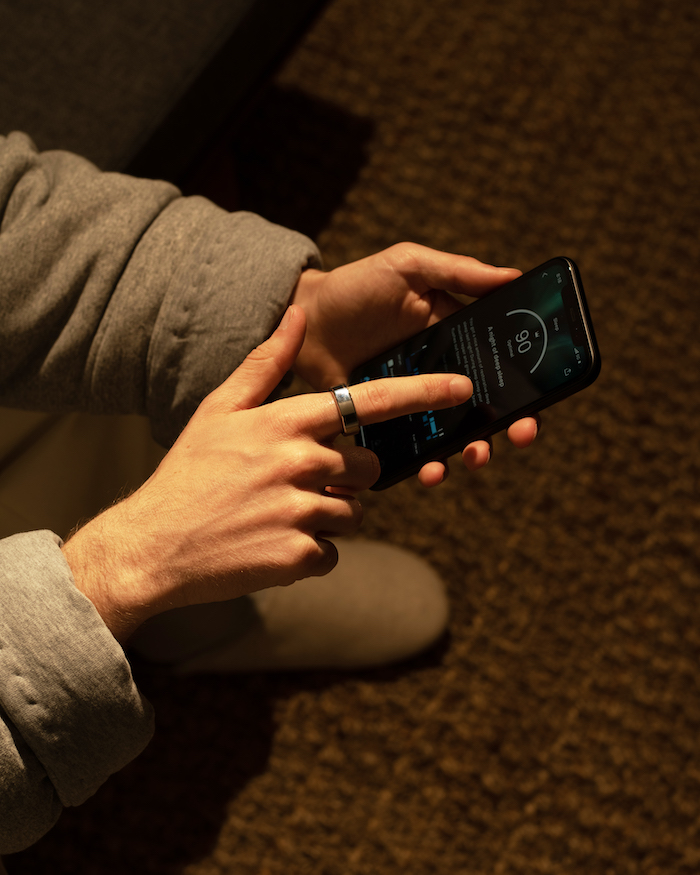- Light sleep, making up about 50% of total sleep, plays a crucial role in memory consolidation, creativity, and physical restoration — but how much light sleep do you need?
- Despite its name, light sleep includes important processes like muscle relaxation, heart rate slowing, and significant brain activity essential for health.
- Oura tracks sleep stages, helping users understand and optimize their light sleep for better overall health and daily performance.
Despite its name, light sleep is no lightweight when it comes to your health. It’s a key stage of sleep that delivers benefits to your brain and body, including codifying memories and boosting creativity. And that’s nothing to sleep on, given that about half of your time asleep — about 50% — is spent in this stage.
“There’s a misconception that people think ‘light sleep’ is bad just because there’s ‘light’ in the name,” says Raphael Vallat, PhD, senior machine learning data scientist at Oura. “But so many fundamental processes of sleep happen during light sleep.”
Quick rewind: Your sleep is divided into two main types, non-REM (NREM) sleep and rapid-eye movement (REM) sleep. NREM sleep is further subdivided into stages: NREM stages 1 and 2 are known as light sleep, and stages 3 and 4 are deep, or slow-wave, sleep.
While each sleep stage benefits your body and mind, light sleep delivers certain essential benefits that you don’t want to miss out on — keep reading to find out more.
| Member Tip: Oura members can see how much light sleep they get each night on the Oura App. |
What is Light Sleep?
Light sleep is a key sleep stage. If you’re wondering, “is light sleep restorative?” You’ll be pleased to discover that it most definitely is. But what happens during light sleep?
Light sleep actually occurs in two stages: NREM stages 1 and 2 sleep. Think of NREM stage 1 as “falling asleep.” During this time, your muscles relax, your heart begins to slow down, and your body temperature dips. Your brain waves slow down, moving from a regular, rhythmic pattern to one with less frequent, less regular waves. Stage 1 sleep usually only lasts a few minutes.
NREM stage 2 sleep makes up the bulk of your NREM sleep. During this stage of sleep, your muscles relax, and may jerk. Your respiration and heart rate slow down. And your body temperature drops. Your brain waves also change, Vallat says: They slow down, and their amplitude increases.
During stage 2, you’ll also experience brain activity known as “sleep spindles.” During these 0.5- to 3-second bursts of nervous system activity, your senses shut down. Scientists believe that these bursts are integral in processing our memories. In fact, much of our memory-building occuring during this stage, especially helping to strengthen weak memories of things we’ve just learned.
Both forms of light sleep are easier to be awakened from than deep sleep, Vallat says. Smaller noises or disturbances are required to rustle you from stages 1 and 2 sleep than deeper forms, and you’re more awake when you are aroused.
“If I wake you from deep sleep, you’re going to be groggy, confused, and it will take a few minutes for you to be back to normal,” he says. This is one reason why doctors recommend that naps last less than 30 minutes. By doing this, you’re less likely to fall into a deep sleep that’s hard to wake up from. “Instead, you stay within that light, stage 2 sleep, and don’t transition into the deep sleep — it’s easier to wake up from stage 2.”
READ MORE: How Long Should You Nap?
How Much Light Sleep Do You Need?
Stage 1 light sleep is short, lasting just a few minutes as you fall asleep. As for NREM stage 2? Studies show you spend about half of your nightly shuteye — between 45 and 55% — in this stage. If you’re sleeping the recommended 7 to 9 hours per night, that means that you’ll spend about 3 to 5 hours per night in stage 2. As you age, the amount of stage 2 light sleep that occurs increases, while the time you spend in deep and REM sleep decreases.
In the first half of a night’s sleep, more of your NREM sleep will be in deep sleep, aka stages 3 or 4. But as the night wears on, studies show that stages 3 and 4 become less of your NREM sleep, and may even disappear. As a result, more of your sleep during this period will be stage 2 light sleep.
Can You Get Too Little Light Sleep?
If you’re falling short on the recommended 7 to 9 hours of sleep per night, you likely aren’t getting enough light sleep. Sleep deprivation, as you likely know, can lead to a host of health issues, from a weakened immune system in the short term to elevated risk of heart disease in the long term.
Spending less time in stage 1 isn’t necessarily a bad thing, though: When people exercise, for example, studies show they fall asleep faster and wake up less often. When you don’t have to fall back asleep as many times during the night, you’re spending less time in stage 1.

Can You Get Too Much Light Sleep?
An increase in the amount of stage 1 sleep can be a sign of sleep apnea, Vallat says: “The apnea events wake you up out of sleep, and then you have to transition back to sleep,” leading to an increase in light sleep and a reduction in deep or REM sleep.
Too much stage 2 light sleep is less likely to be a problem, he says, unless you’re getting enough total sleep without getting ample REM or deep sleep. Your Oura Sleep Score can show you how much of each of these stages of sleep you’re getting, with the optimal amount of REM being somewhere between 90 to 120 minutes and deep sleep being 45 to 90 minutes per night.
Note that as people age, you can expect to get less deep sleep — and more light, stage 2 sleep. “If you’re 70 years old, for instance, most likely you’re going to have 30 to 50 minutes of deep sleep, and at least 60 percent of your night is going to be light sleep,” Vallat says. “And that’s normal. It’s nothing to worry about.”
Other causes of increased light sleep include certain medications: For example, studies show that people taking medication such as benzodiazepines may have a greater proportion of light sleep, partially coming at the expense of deep, slow-wave sleep.
What are the Benefits of Light Sleep?
Light sleep is restorative, and comes with some key benefits to your sleep quality and overall health.
Codifies Memories
As we learned above, stage 2 sleep is believed to be important in memory consolidation, the process by which some short-term memories are turned into long-term memories, and others are forgotten. Sleep spindles, the bursts of nervous system activity in stage 2 sleep associated with codifying memories, have been found to happen more often after a study session.
Enhances Motor Skills
Research suggests light sleep can help improve motor skills — tasks that involve moving and coordinating muscles. In 2007, Matthew Walker, Ph.D., a UC Berkeley Professor, author of Why We Sleep, conducted a study in which subjects learned a new fine motor skill. Half the group took a midday nap, while the other half did not. Then, 8 hours after learning the task, both groups were tested.
The findings: The group who took the nap did better on the test, and Walker and his colleagues found a significant correlation between stage 2 light sleep and improved learning.
Boosts Creativity
We usually associate dreaming with REM sleep, but stage 1 light sleep can also be dream-filled and may help us solve creative problems, according to a 2021 study.
In the study, scientists gave subjects a math problem with a “hidden rule.” When subjects were allowed to drift off to sleep, but were then awakened during stage 1, they were three times more likely to have a “eureka” moment and realize the problem’s trick.
Fun fact: This is similar to a technique used by Thomas Edison, Vallat says: The inventor would take short naps while holding a metal sphere. “If he fell too deep asleep, the sphere would fall out of his hand and wake him up,” he says. Edison could then quickly try to recall what he was thinking about as he fell asleep and tap his creative findings.
Physical Restoration and Repair
While deep sleep — aka NREM stage 3 and 4 — is most often associated with physically restorative processes for our brain, muscles, and organs, these process also occur during stage 2 light sleep, Vallat says.
“NREM sleep is kind of a continuum — it’s a spectrum,” he says. In other words, there’s not a hard, fast line between stage 2 and stage 3 NREM sleep, where things only happen in one or the other. “All these processes that are occurring in deep sleep are, to some extent, happening during stage 2.”
READ MORE: How Sleep Helps Muscle Recovery and Growth
How Accurate is Oura Ring at Detecting Light Sleep?
Wondering how accurate Oura is at distinguishing between light sleep and REM? Good news: According to recent external validation studies, sleep staging accuracy ranged between 75.5 % (light sleep) and 90.6 % (REM sleep). The Oura Ring had a sensitivity of 94.4 % to 94.5%. In fact, these studies found that Oura Ring did not “significantly differ” from gold standard sleep lab testing (PSG).
The researchers concluded: “Oura has high sensitivity and specificity with almost perfect agreement with PSG for 2-stage sleep classification, and an inter-device reliability of 94.8 %.” That means that Oura is so accurate; it’s like having an entire sleep lab right there at your fingertips.
READ MORE: Oura Accuracy Further Validated by New Study from the University of Tokyo
About the Oura Expert
Raphael Vallat, PhD, is a senior machine learning data scientist at Oura. He previously worked as a sleep researcher in the Center for Human Sleep Science at the University of California, Berkeley (Prof. Matt Walker‘s lab). He has published extensively on the topic of sleep and human health, and his work has been featured in several major news media and podcasts. In his free time, you can find him enjoying precious moments with his amazing wife and daughter, playing music, or hiking with friends.










